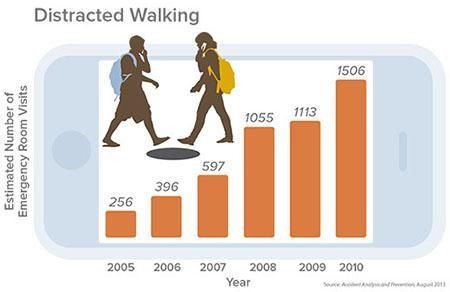Facebook User Glued To Her Phone Falls Off Pier: The Dangers Of Distracted Walking

The advent of smartphones has made life more interesting in the palm of our hands than in the massive sprawl of earth around us. So maybe it was a sign that a woman in her mid-twenties fell off St. Kilda’s Pier in Melbourne, Australia, because she was too busy checking Facebook to notice the pier was ending.
Distracted walking — that illustrious 21st-century problem where people can’t spare a few seconds from their phones to ensure they aren’t walking into traffic (or off a pier) — actually has some startling data behind it. Since 2004, injuries sustained through distracted walking have doubled. Researchers estimate the rates will double again by 2015, and given the bevy of unreported cases due to sheer embarrassment, the actual rates may be much higher than the data suggests.
Luckily, last week’s splashdown left the unnamed woman injury-free, according to a report in The Age. While the woman couldn’t swim, Senior Constable Dean Kelly of the water police squad said she was wearing a backpack that allowed her to float safely on her back. When authorities rescued her from the frigid Port Phillip Bay, Kelly said the woman was still clutching her phone.
"She had a mobile phone in one of her hands and when we brought her onboard one of the first things she did was apologize and say sorry," Kelly told The Age. "She was fine. She wasn't hypothermic. She just needed a blanket to warm up.”
Watch Your Step
The woman fared better than the 1,506 people in 2010 who sustained distracted walking injuries. Jack Nasar, professor of city and regional planning at the Ohio State University and co-author of a recent study into distracted walking, argues the hazards of walking with an affixed downward gaze should now be likened to those of distracted driving.
While the rates still outpace distracted walking by a considerable margin — 387,000 distracted driving injuries occurred in 2011 — the trends are traveling in opposite directions. According to the Centers for Disease Control and Prevention (CDC), distracted driving declined from 416,000 in 2010 and overall distracted walking declined from 97,000 to 41,000 over Nasar’s seven-year study. Meanwhile, injuries sustained while on the phone rose from 559 in 2004.
"The role of cell phones in distracted driving injuries and deaths gets a lot of attention and rightly so," Nasar said in a statement. "But we need to also consider the danger cell phone use poses to pedestrians."

Indeed, the woman’s long walk off a short pier is congruent with Nasar and his colleagues’ data: people between 21 to 25 years old comprised the largest chunk of the injuries, at 1,003. Sixteen to 20-year-olds made up the next largest cohort, at 985 total injuries. Together with former OSU graduate student, Derek Troyer, the team mined the National Electronic Injury Surveillance System, which collects injury samples from over 100 national hospitals. While they argue their data does a sufficient job of reporting distracted walking injuries’ rise, the data may belie its true prevalence — to the tune of some two million more injuries than the data bears out.
"It is impossible to say whether 2 million distracted pedestrians are really injured each year," Nasar said. "But I think it is safe to say that the numbers we have are much lower than what is really happening."
Nasar and Troyer’s data diverges from the recent woman’s Facebook-spurred plunge in that 69 percent of all injuries are sustained while talking on the phone. Texting and playing games only accounted for nine percent of cases. And as the basic wisdom advises, the easiest way to avoid becoming one of Nasar and Troyer’s data samples is simply to look where you’re going, and to teach kids to the same.
“Parents already teach their children to look both ways when crossing the street,” Nasar explained. “They should also teach them to put away their cell phone when walking, particularly when crossing a street."



























